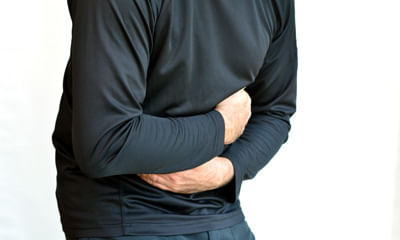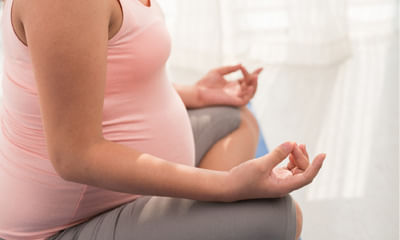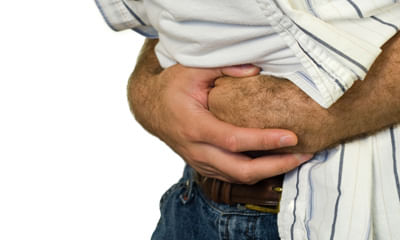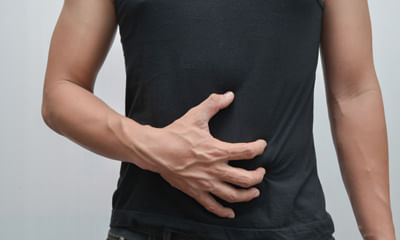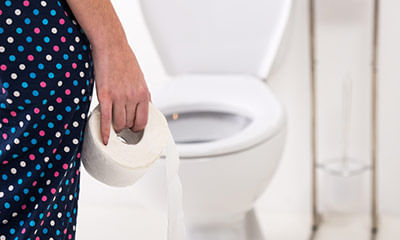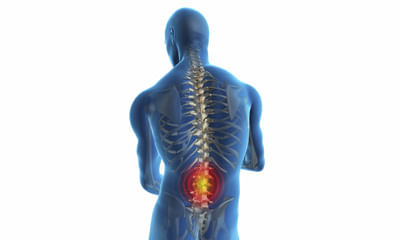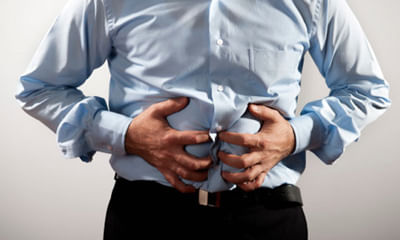Black Stool Constipation Abdominal Pain
I am having three four times stools daily from 10 days n it's solid stool not diarrhea n there is burning sensation whil ...
Ask Free Question
Monitor the types and amounts of food you consume. Often times, frequent trips to the bathroom can be indicative of a food allergy or intolerance Eat only at meal times. Snacking can add to the amount of poop you will need to get rid of from your body, and also increases the regularity and continuity with which stool progresses to its exit. If you must eat, eat moderately. Take care in consuming dairy products. Lactose intolerance is a common condition found in adults. People who are lactose intolerant cannot break down the lactose sugar found in dairy products. Symptoms include abdominal pain, bloating and diarrhea. Avoid coffee and other caffeinated drinks. Caffeine stimulates the muscles that are responsible for producing stool Cut down on high-fiber foods. Consuming an excess of foods with high fiber content can increase the frequency of bowel movements. Avoid drinking alcohol in excess. Alcohol can also cause diarrhea and may exacerbate bowel-related medical conditions such as Irritable Bowel Syndrome (IBS). If you're eating an excessive amount of fruits and vegetables, which contain high amounts of fiber, you may want to cut back. Manage your stress levels.] Stress may contribute to increased bowel movement frequency and can cause diarrhea. People often feel anxious about relationships, finances, education exams, or other big life events. FOR MEDICATION CONSULT ONLINE IN PRIVATE
I wants to ask what's are the cause and symptoms of cancer. Symptoms of 1st 2nd and last stage. ...
Ask Free Question
Cancer is caused by uncontrolled growth of cells in an area of our body. It can be due to loss of function of tumor suppressor genes or due to increased function of oncogenes. There are many cancers and that many causes of cancer. If localised, it may form a lump or swelling. Usually painless. If it has spread i.e. Stage 4, then symptoms due to the affected site or organ can occur. E.g. Breathlessness or hemoptysis in lung, jaundice in liver, ascites with abdominal distension in peritoneum, bone pain or fracture in bony mets, convulsion, vomiting and signs of raised intracranial hypertension in brain mets. It is not possible to write about all cancers and all itâs symptoms. I will enumerate a few causes and symptoms of common cancers in non metastatic settings. Please note that most cancers donot have any cause and are asymptotic 1) Oral cavity and laryngeal cancers Symptoms: ulcer, Leukoplakia or erythroplakia rarely pain, neck node swelling, hoarseness of voice Cause: tobacco, alcohol, smoking, HPV, sharp tooth or ill fitting dentures with chronic trauma 2) Breast Cancer Symptoms: lump, nipple discharge especially blood stained, armpit swelling, nipple retraction, skin redness or thickening, skin dimpling Cause: increasing age and female sex are the most important non modifiable risk factors. Others include obesity, increased estrogen exposure due to early menarche, late menopause, no breast feeding, no children, OC pills, HRT, obesity. Familial due to BRCA genes 3) Colon or rectal cancer: Symptoms: bleeding per Rectum, alternating constipation or loose motions, lump in abdomen, intestinal obstruction Causes: Age, low fibre diet, Familial in AFP or HNPCC 4) kidney cancer Symptoms: Pain, lumbar swelling, hematuria Cause: Smoking, familial 5) urinary bladder cancer Symptoms: Hematuria, urinary retention Causes: smoking 6) lung cancer Symptoms: cough, hemoptysis, breathing difficulty, hoarseness of voice Causes: smoking 7) esophageal cancer Symptoms: difficulty in swallowing food, Causes: smoking, smoked fish 8) stomach cancer Symptoms: black stools, hematemesis, lump in abdomen, obstruction with vomiting Causes: smoking, alcohol 9) liver cancer Symptoms: lump in abdomen Causes: hepatitis B infection with cirrhosis, toxins 10) gall bladder cancer Symptoms: asymptotic, lump in abdomen, jaundice Cause: gall stones, cholesterosis 11) prostate cancer Symptoms: urinary retention, hematuria Cause: age, androgens 12) penile cancer Symptoms: ulcer Cause: HPV related 13) ovarian cancer Symptoms: mass in pelvis Cause: familial 14) endometrial cancer Symptoms: post menopausal bleeding or inter menstrual bleeding Cause: hormonal 15) cervical cancer Symptoms: bleeding pv Cause: HPV related 16) pancreatic cancer Symptoms: jaundice, lump in abdomen Cause: smoking 17) bone cancers: Symptoms: swelling, pain, fracture Cause: multifactorial 18) skin cancer Symptoms: ulcer or black lesion Cause UV rays 19) brain tumor Symptoms: neurological deficit, vomiting, visual deficit Causes: multifactorial 20) blood cancer Symptoms: bleeding, infections Cause: genetic, multifactorial 21) Testicular Cancer Symptoms: testicular painless swelling, abdominal lump Cause: genetic, multifactorial.
How cancer causes? What happen in our body when we are suffering from this? And by which organism ,cancer causes? ...
Ask Free Question
Cancer is caused by uncontrolled growth of cells in an area of our body. It can be due to loss of function of tumor suppressor genes or due to increased function of oncogenes. There are many cancers and that many causes of cancer. If localised, it may form a lump or swelling. Usually painless. If it has spread then symptoms due to the affected organ can occur. It is not possible to write about all cancers and all it's symptoms. You can read a book called Devita, Hellman, and Rosenberg's Cancer: Principles and Practice of Oncology if you want all the symptoms and causes. It is considered a bible of oncology (but the treatment is ever changing) I will enumerate a few causes and symptoms of common cancers in non metastatic settings. Please note that most cancers donot have any cause and are asymptotic 1) Oral cavity and laryngeal cancers Symptoms: ulcer, Leukoplakia or erythroplakia rarely pain, neck node swelling, hoarseness of voice Cause: tobacco, alcohol, smoking, HPV, sharp tooth or ill fitting dentures with chronic trauma 2) Breast Cancer Symptoms: lump, nipple discharge especially blood stained, armpit swelling, nipple retraction, skin redness or thickening, skin dimpling Cause: increasing age and female sex are the most important non modifiable risk factors. Others include obesity, increased estrogen exposure due to early menarche, late menopause, no breast feeding, no children, OC pills, HRT, obesity. Familial due to BRCA genes 3) Colon or rectal cancer: Symptoms: bleeding per Rectum, alternating constipation or loose motions, lump in abdomen, intestinal obstruction Causes: Age, low fibre diet, Familial in AFP or HNPCC 4) kidney cancer Symptoms: Pain, lumbar swelling, hematuria Cause: Smoking, familial 5) urinary bladder cancer Symptoms: Hematuria, urinary retention Causes: smoking 6) lung cancer Symptoms: cough, hemoptysis, breathing difficulty, hoarseness of voice Causes: smoking 7) esophageal cancer Symptoms: difficulty in swallowing food, Causes: smoking, smoked fish 8) stomach cancer Symptoms: black stools, hematemesis, lump in abdomen, obstruction with vomiting Causes: smoking, alcohol 9) liver cancer Symptoms: lump in abdomen Causes: hepatitis B infection with cirrhosis, toxins 10) gall bladder cancer Symptoms: asymptotic, lump in abdomen, jaundice Cause: gall stones, cholesterosis 11) prostate cancer Symptoms: urinary retention, hematuria Cause: age, androgens 12) penile cancer Symptoms: ulcer Cause: HPV related 13) ovarian cancer Symptoms: mass in pelvis Cause: familial 14) endometrial cancer Symptoms: post menopausal bleeding or inter menstrual bleeding Cause: hormonal 15) cervical cancer Symptoms: bleeding pv Cause: HPV related 16) pancreatic cancer Symptoms: jaundice, lump in abdomen Cause: smoking 17) bone cancers: Symptoms: swelling, pain, fracture Cause: multifactorial 18) skin cancer Symptoms: ulcer or black lesion Cause UV rays 19) brain tumor Symptoms: neurological deficit, vomiting, visual deficit Causes: multifactorial 20) blood cancer Symptoms: bleeding, infections Cause: genetic, multifactorial I may have missed many. Have put down what came to my mind.
Hi, It's my 8th month of pregnancy. Is it safe to use ADENOXYL HB tablet during this month of pregnancy. It was prescrib ...
Ask Free Question
Hi Nikhat... It is a b complex tablet mostly and yes you should take it.. your doctor is aware of the side effects... And you will find similar listings of side effects with every allopathic medicine... You may replace the tablet with Amway nutrilite product...
I am using medicine for gastric about 3 months. And now I stopped to use. As soon as I stopped to use these medicines, I ...
Ask Free Question
Dipendra ji, details that you describe about your problem indicates that there may be ulcer in your stomach. Because as you said when you pass stool there is discharge of black coloured blood which means there is bleeding somewhere from upper gastic lining that is stomach or small intestine. You should follow there remedies: 1. Make a mixture by adding mulethi powder and dhaniya powder 100gm each and mishri 200gm , take 1 tsp of this powder twice daily empty stomach. 2.Start taking amlapittmishram of dhootpapeshwar company ,take 2 tsp of it 3 times a day before meal . 3.Avoid junk food, deep fried food,spicy food, tea ,coffee.
I feel Uneasiness in stomach, feeling pain sometimes in the upper and lower part of stomach. ...
Ask Free Question
Hi as per your query it seems you are suffering APD (acid peptic disorder), for which you may require some tests 1 USG W/ABD, CBC, URINE C/E, Gastritis is a condition in which the stomach liningâknown as the mucosaâis inflamed, or swollen. Causes of gastritis are nonsteroidal anti-inflammatory drugs, drinking alcohol, smoking, stress, infections with viruses, parasites, fungi, and bacteria other than H. Pylori, symptoms, upper abdominal discomfort or pain, nausea,vomiting, shortness of breath, dizziness or feeling faint, red blood in vomit, black, tarry stools, red blood in the, stool,weakness, paleness. Feel free to contact me through Lybrate.
I am having serious gastric problem for past few months. But since last one week I am continuously going through Watery ...
Ask Free Question
Black colour stool may be due to constipation/ any medicine taken like Iron supplements or may be due to Upper GI bleeding get Stool R/M and USG abdomen done and review with reports.
Bloody stool, frequent urge for stool but less volume is evacuated each time. 2 days duration. Has previous history of b ...
Ask Free Question
Blood in the stool can be frightening, whether you discover it while wiping after a bowel movement or from a test ordered by your health care provider. While blood in stool can signal a serious problem, it doesn't always. Here's what you need to know about the possible causes of bloody stools and what you -- and your doctor -- should do if you discover a problem. Causes of blood in stool blood in the stool means there is bleeding somewhere in your digestive tract. Sometimes the amount of blood is so small that it can only be detected by a fecal occult test (which checks for hidden blood in the stool). At other times it may visible on toilet tissue or in the toilet after a bowel movement as bright red blood. Bleeding that happens higher up in the digestive tract may make stool appear black and tarry. Possible causes of blood in stool include: diverticular disease. Diverticula are small pouches that project from the colon wall. Usually diverticula don't cause problems, but sometimes they can bleed or become infected. Anal fissure. A small cut or tear in the tissue lining the anus similar to the cracks that occur in chapped lips or a paper cut. Fissures are often caused by passing a large, hard stool and can be painful. Colitis. Inflammation of the colon. Among the more common causes are infections or inflammatory bowel disease. Angiodysplasia. A condition in which fragile, abnormal blood vessels lead to bleeding. Peptic ulcers. An open sore in the lining of the stomach or duodenum, the upper end of the small intestine. Many peptic ulcers are caused by infection with a bacterium called helicobacter pylori (h. Pylori). Long-term use or high doses of anti-inflammatory drugs such as aspirin, ibuprofen, and naproxen can also cause ulcers. Polyps or cancer. Polyps are benign growths that can grow, bleed, and become cancerous. Colorectal cancer is the fourth most common cancer in the u. S. It often causes bleeding that is not noticeable with the naked eye. Esophageal problems. Varicose veins of the esophagus or tears in the esophagus can lead to severe blood loss. Blood in stool diagnosis it is important to have a doctor evaluate any bleeding in the stool. Any details you can give about the bleeding will help your doctor locate the site of bleeding. For example, a black, tarry stool is likely an ulcer or other problem in the upper part of the digestive tract. Bright red blood or maroon-colored stools usually indicate a problem in the lower part of the digestive tract such as hemorrhoids or diverticulitis. After getting a medical history and doing a physical exam, the health care provider may order tests to determine the cause of bleeding. Tests may include: nasogastric lavage. A test that may tell your doctor whether bleeding is in the upper or lower digestive tract. The procedure involves removing the contents of the stomach through a tube inserted into the stomach through the nose. If the stomach does not contain evidence of blood, the bleeding may have stopped or is more likely in the lower digestive tract. Esophagogastroduodenoscopy (egd). A procedure that involves inserting an endoscope, or flexible tube with a small camera on the end, through the mouth and down the esophagus to the stomach and duodenum. The doctor can use this to look for the source of bleeding. Endoscopy can also be used to collect small tissue samples for examination under a microscope (biopsy). Colonoscopy. A procedure similar to an egd except that the scope is inserted through the rectum to view the colon. As with an egd, colonoscopy can be used to collect tissue samples to biopsy. Enteroscopy. A procedure similar to egd and colonoscopy used to examine the small intestine. In some cases this involves swallowing a capsule with a tiny camera inside that transmits images to video monitor as it passes through the digestive tract. Barium x-ray. A procedure that uses a contrast material called barium to make the digestive tract show up on an x-ray. The barium may either be swallowed or inserted into the rectum. Radionuclide scanning. A procedure that involves injecting small amounts of radioactive material into a vein and then using a special camera to see images of blood flow in the digestive tract to detect where bleeding is happening. Angiography. A procedure that involves injecting a special dye into a vein that makes blood vessels visible on an x-ray or computerized tomography (ct) scan. The procedure detects bleeding as dye leaks out of blood vessels at the bleeding site. Laparotomy. A surgical procedure in which the doctor opens and examines the abdomen. This may be necessary if other tests fail to find the cause of bleeding. Health care providers also order lab tests when there is blood in stools. These tests may look for clotting problems, anemia, and the presence of h. Pylori infection. Associated symptoms a person with blood in the stool may be unaware of bleeding and might have reported no symptoms. On the other hand, they may also have abdominal pain, vomiting, weakness, difficulty breathing, diarrhea, palpitations, fainting, and weight loss depending on the cause, location, length, and severity of the bleeding. Depending on the cause, however, treatment may involve simple things you can do on your own. These including eating a high-fiber diet to relieve constipation that can cause and aggravate hemorrhoids and anal fissures, and sitting in warm or hot baths to relieve fissures.
What works do and we are always fit sir I always to trying to fit but I can not any time I play Cricket and Suddenly Sta ...
Ask Free Question
To remain healthy and Fit ,you should follow 3 steps in your life 1.BALANCED DIET 2.EARLY MORNING BRISK MORNING WALK for 30 minutes and 10 minutes evening walk after Dinner 3.DRINK 6-8 Glasse of water daily. As 60% of our body is made of water, it acts as a carrier of essential nutrients inside our body. Loosing as little as 5% of body's weight as water can cause headache, fatigue and lower your muscle strength. To stay healthy, an adult should drink at least 8 glasses of water everyday. Balanced Diet= 60% Carbohydrates + 20% Fats + 20% Proteins 1. Carbohydrates: Our main source of energy. Stored in liver and muscles. Carbohydrates are used the most by our body duringexercise. Hence, it is important for people who exercise regularly to consume a diet rich in carbohydrates. (a) Instant/rapid carbohydrates energy sources: Banana, Milk, Sweets, Sugarcane juice. (b) Slow carbohydrates energy sources: Beans, Bread, Cereals, Potato, Pulses, Rice. 2. Proteins: Essential for growth, repair of muscle, skin, hair and body tissues. Protein deficiency leads to low immunity, hairfall, feeling of tiredness. Proteins are not stored in our body as any excess protein is converted to energy or fat. Hence, a person requires protein intake every day. When the body does not get enough carbohydrates to fuel itself, it falls back on protein bank. That is why people who follow starvation diets or go on fasting lose muscle tissue. (a) Major protein sources: Egg white(white portion), Milk, Soybeans/Soymilk, Fish, Cheese, Tofu. (b) Other protein sources: Beans with wheat, Nuts, Curd, Yogurt (Dahi). 3. Fats: Required and healthy when taken in small amounts. Excess fat leads to weight gain, increase in bad cholesterol (LDL) and heartproblems (a) Major fats sources: Egg yolk (Yellow portion), Avocados, Whole Milk, Butter, Cheese, Nuts. (b) Other fats sources: Corn, Vegetable/Olive oil, Biscuits, Flaxseeds(San Beej). 4. Vitamins and Minerals: Critical for normal functioning of organs and processes within our body. They do not provide energy directly but work behind the scenes to break down food into energy. 5. Fiber: It helps retain water and in making our stools softer to avoid constipation. Intake should be 25 to 35 grams a day. 6. Calories: A measure of how much energy food or drink contains. On an average, a man needs around 2,000 calories a day and a woman 1700 calories a day to maintain his weight and good health. Number varies by person depending upon weight, age and how active the lifestyle is. 7. Guideline: Each day have 3 main meals, 2 snacks, 5 pieces of fruit and at least 1 glass of milk. 4. BRAMARI PRANAYAM or Bee Breath 1.Close your eyes. Focus on your breathing. 2.Place your thumbs in your ears, your index fingers above your eyebrows, and your remaining along the sides of your nose. Keep each pinky finger near a nostril. 3.Breath in deeply through the nose. First, feel the diaphragm move down, allowing the lungs to expand and forcing the abdomen out; then feel your chest expand with your collar bones rising last. .4.Use your pinkies to partially close each nostril. Keep your lungs filled. .5.Breathe out through the nose while humming. Note that the humming sound should originate in your throat, not as a result of your partially-blocked nostrils. 6.Repeat twenty times.starting from 5 times In Nut-Shell,THINK GOOD,EAT GOOD,SLEEP GOOD andby adopting these 3 point in your life you will remain fit as ever.
I am 20 years old. I have duodenal ulcer. From last week I am suffering from constipation. I am taking laxative 10ml. Cr ...
Ask Free Question
Avoid spicy food in your diet and take more of liquid diet and take medication only from a gastroenterologist

